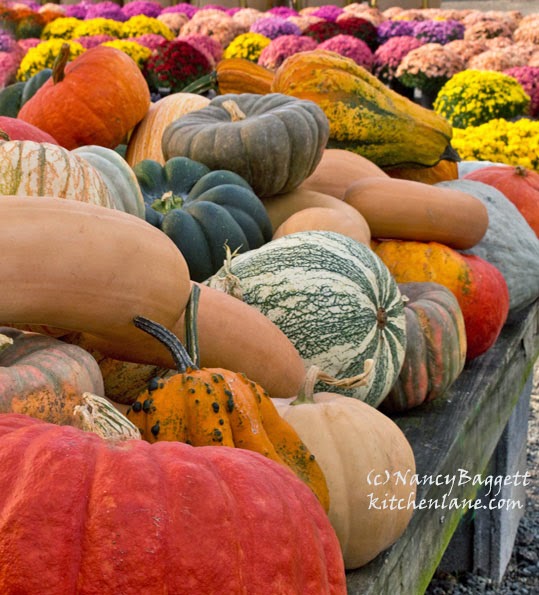
If you haven’t been to a farmers’ market or pick-your-own farm to buy Halloween pumpkins and squashes recently, you may not be aware of what the most fashionable fruits (yes, pumpkins are fruits) are wearing these days. It’s a far cry from that basic orange of the vast fields in the Charlie Brown “Great Pumpkin” movies of several decades ago. In some cases, the offerings are downright weird.
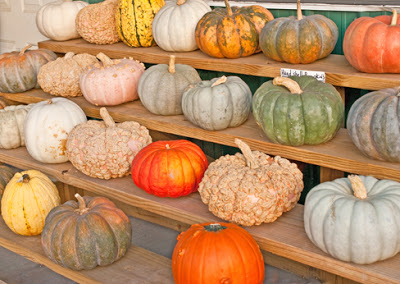
Almost every orb who’s anybody in the patch is sporting trendy, subtle designer shades like those shown above–think bleached oyster,stonewashed sage, peek-a-boo peach (below) or striated maize. Plain orange is considered just sooo unsubtle and ORDINARY these days!
And note that the smooth, unblemished skin that used to be deriguer for aspiring top models is passe. Lumps, bumps, and wrinkles are prized for lending character. Warts are in, the more the better! The one above right and second down on the left (quite a hot item now) has been aptly dubbed “peanut pumpkin” because it looks a lot like it’s been rolled in discarded peanut shells. The official name of this variety, a French heirloom from a southern town called Eysines, is Brodé Galeux d’Eysines; this translates as “embroidered with warts from Eysines.”
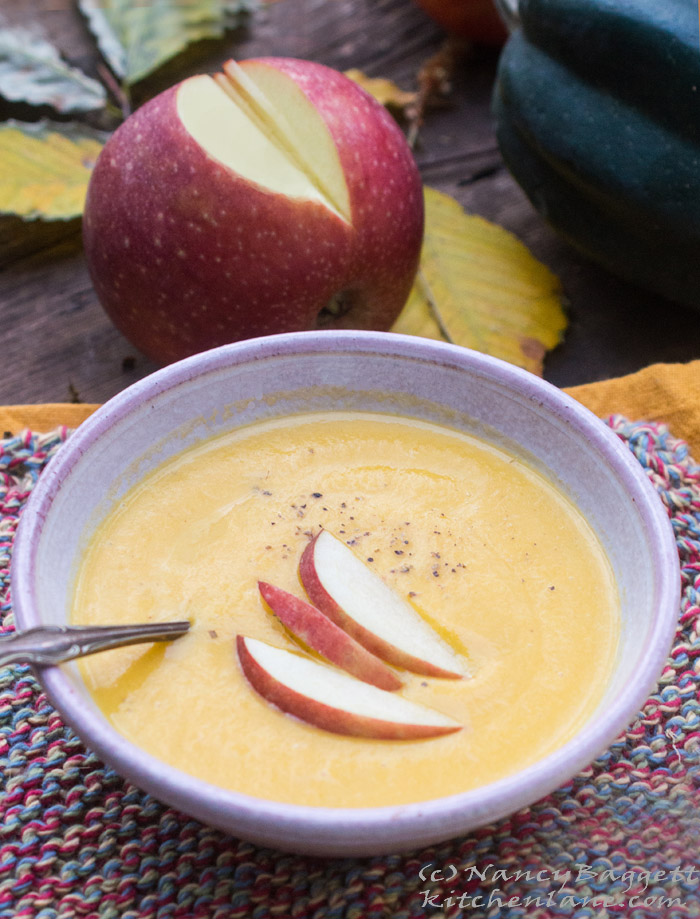
Considering the odd-looking outside of peanut pumpkins, I was surprised to discover that they are very tasty baked and even better in soup–a bit like acorn squash, but softer. And their flesh is thick and a bright, deep orange that is strikingly pretty. However, don’t buy with the intention of carving them; the shells are extremely hard and the task will be frustrating instead of fun. Another lesser known squash that’s a hu-hum green on the outside (below) but has an unbelievably brightly colored flesh and tastes wonderful roasted or microwaved is called Fairytale, shown cut into slices here. (You might be tempted to think the color has been manipulated through photoprocessing, but it’s totally natural! It can add rich color to dishes, such as the Harvest Bisque recipe below.
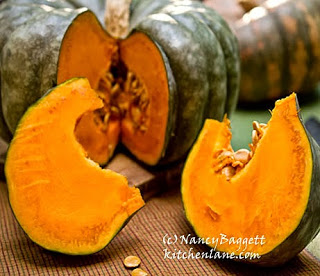
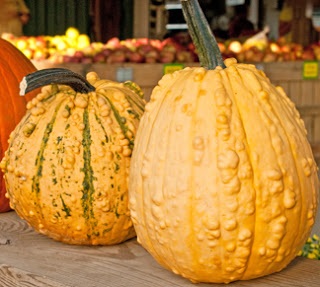 Lately, American pumpkin seed purveyors have actually been squabbling over who has the right to sell seeds of certain gnarly kinds. One company attempted to patent a “new” pimpled variety that detractors claim has been been around for centuries. Writes Grit editor-in-chief Hank Will:
Lately, American pumpkin seed purveyors have actually been squabbling over who has the right to sell seeds of certain gnarly kinds. One company attempted to patent a “new” pimpled variety that detractors claim has been been around for centuries. Writes Grit editor-in-chief Hank Will:
“In an interesting move in the wholesale garden seed supply industry, Siegers Seed Company in Holland, Michigan has been quietly pushing an all-encompassing patent application through the system that would essentially allow them to own a piece of genetic history in the pumpkin and squash families. Siegers’ move appears to be aimed at owning the rights to virtually all warts on pumpkins and their relatives. And they want to own the rights to all patches in which warted pumpkins appear. Huh? My ancestors grew warted gourds, pumpkins and squashes long before Siegers was even in business, and they received the seed from Native American gardeners who had warted cucurbits in their patches for who knows how long…..”
For more details, plus a late 1700s image of an orange pumpkin with warts, check out the Grit story here.
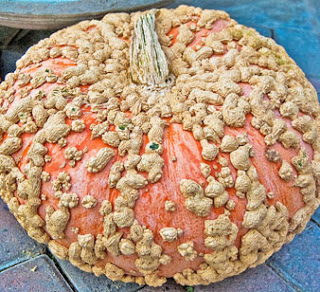
Actually, all these curious, non-traditional-looking pumpkin shapes and colors made me wonder whether in fact some of them might technically be called “hard-shelled squashes” instead. However, a little research on the topic didn’t enlighten. A couple sources said pumpkins tend to have tougher stems than their cucubit cousins–not terribly helpful. So I’m just not going to worry about botanical correctness.
Autumn Harvest Bisque
As you can see from the pics above, the produce place I visited was loaded with apples and other harvest bounty, which, of course, I couldn’t pass up. So, I decided to put some of it to work in the wholesome cool-weather soup offered here.
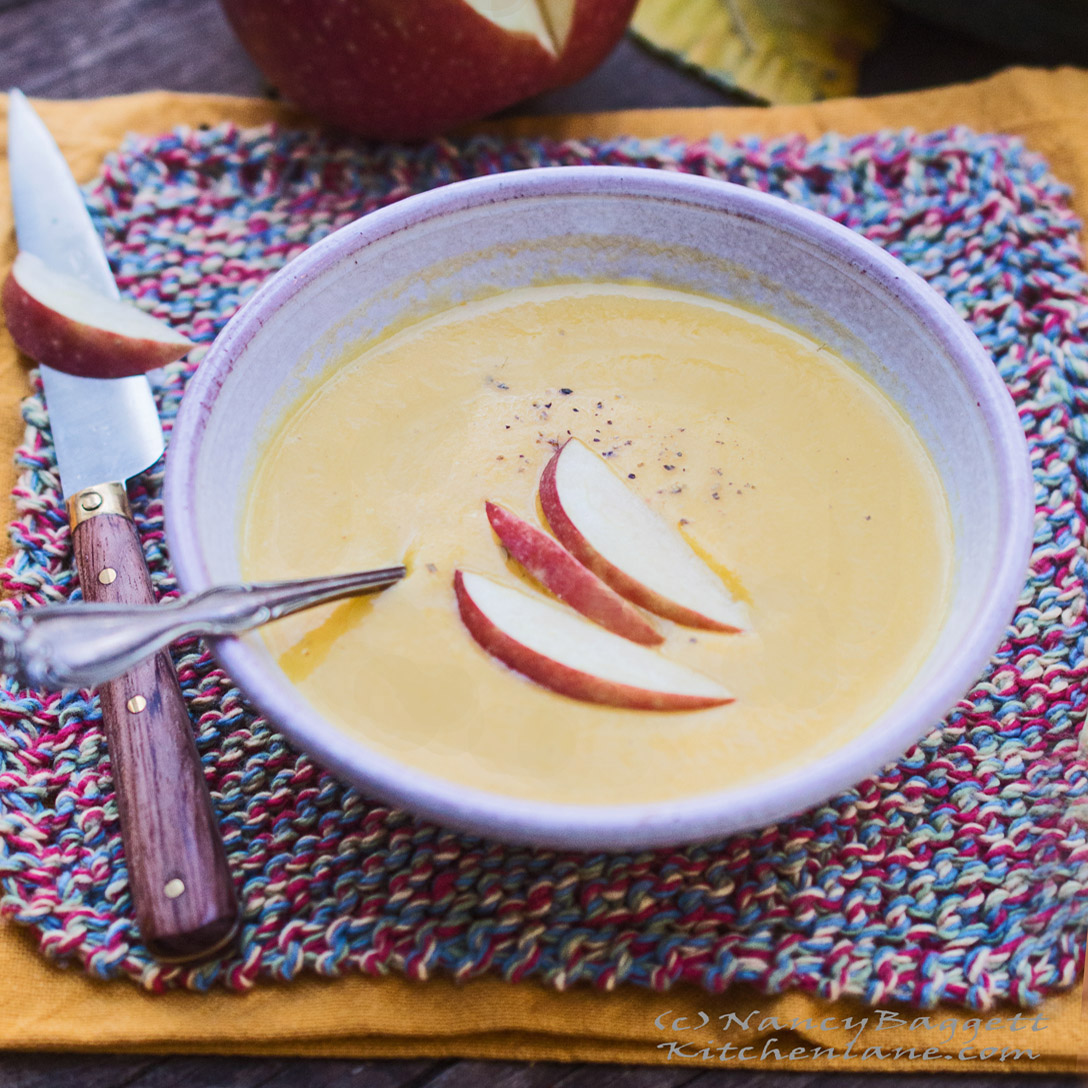
Featuring apples, several root vegetables including carrots and parsnips (don’t leave them out), and winter squash or eating pumpkin, this simple, healthful bisque really captures the spirit of the season. It is fragrant, delicious and colorful, and makes a fine starter for Thanksgiving dinner or any festive cool weather meal. I love it for lunch. It is gluten-free and can be free of dairy if you wish; I like to add in a half cup of cream for a little extra richness, but this is entirely optional.
- 1 large onion, chopped
- 1½ tablespoons unsalted butter (or substitute 1½ tablespoons olive oil if desired)
- 2 cups peeled and chopped sweet-tart apples (such as Golden Delicious or Honeycrisp)
- 1½ cups peeled and chopped parsnips
- 1 cup peeled and coarsely chopped peeled Acorn, Hubbard, Fairytale or other winter squash
- 1 cup peeled and finely chopped carrot
- 1 teaspoon ground coriander
- 1 teaspoon minced fresh ginger root
- ½ teaspoon dried thyme leaves, crumbled
- About 4 cups reduced-sodium or regular chicken broth
- ½ cup light cream, optional
- Salt and black pepper to taste (optional)
- Fine slices unpeeled apple for garnish
- In a 4-quart saucepan or similar-size soup pot, combine onion and butter.
- Cook over medium-high heat, stirring frequently, 3 or 4 minutes, until onion softens and begins to brown.
- Stir in the apples, parsnips, squash, carrot, coriander, ginger root, and thyme.
- Stir in 3¾ cups broth and bring to a boil over high heat.
- Reduce the heat; simmer, covered, stirring occasionally, until parsnips and carrots are just tender when pierced with a fork, about 15 minutes.
- Let cool slightly.
- In batches, puree until very smooth in a blender. (For a less smooth consistency you can puree using a food processor)
- Return pureed mixture to saucepan over medium heat. Stir in the cream, if using.
- Thin the bisque to the desired consistency with more broth or water.
- Simmer, uncovered, about 5 minutes until flavors are well blended.
- Taste and add salt and pepper, as desired.
- Serve in cups, bowls, or soup plates.
- Garnish servings with several fresh apple slices just before serving.
For another appealing, very traditional autumn recipe, my pumpkin bread pudding, click here.
For a different autumn recipe, check out my pumpkin-cranberry quick bread here.
Or perhaps another soup–my very zippy pumpkin-tomato bisque (a fab combo); go here .
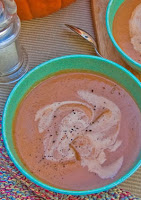
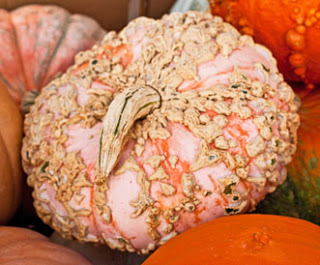
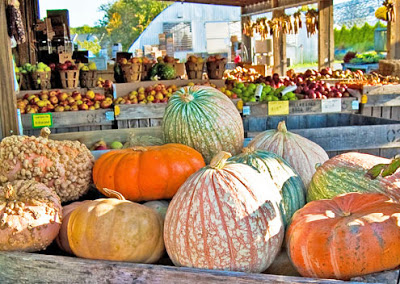
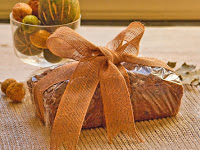

Sally, I have found some of these very hard, though I could get a knife through them by pushing really firmly. No machete required! Others have not been quite as hard. I have a feeling that as they stand out and ripen, they may get a little softer–just a guess.
Nancy, I wonder how hard the peanut pumpkin shells are. Do you need a machete to cut them open to roast? or do you roast them until the shell is soft enough to carve and use in soup? Sounds like a terrific Thanksgiving soup! 🙂
Though the peanut punkins aren't good for carving due to hard shells, they have a beautiful orange color inside and are really tasty cut into servings, baked and then just served with butter and salt and pepper. I used to like acorn squash, but now, when I can get them, buy these instead.
Guess I'll investigate and maybe warn about the warty ones not being carving candidates next fall. Too late to do that this year….
those that found these warty pumpkins impossible to carve, well so did my husband. Took him 1 hour to cut through to make a removable top. Gave up….we'll paint the face.
No info seems to be available. I'm guessing that those who are growing warty pumpkins are focused only on getting the skin to have bumps, not on producing ones that are soft enough to carve. It's probably best to specifically ask for and buy ones raised for carving–then if they are too hard you could get another that did work.
My warty pumpkim tonight was impossible to carve…did the last two figure out how to carve it. It's a rock!
I have also come upon extremely hard acorn and butternut squashes, so wonder if they do soften a bit as they ripen. I've tried to research this but have not found any info to share. Will keep looking and add to the post if I find out anything that's helpful
Ok, what about *really* hard shelled squash/pumpkins? We picked up a creepy wart-covered pumpkin last night, but when we tried to carve it today, it was hard as a rock. Anybody come across this before? Does it have to do with the variety of pumpkin, or is it just not quite ripe yet? It looks ripe, but feels like a stone.
Leslie, I appreciate your info–I'm sure that pumpkins are indeed part of the "hard-shelled squash" family. I'm guessing that as new hybrid varieties are developed and old ones are rediscovered, the distinction between squash and pumpkin will continue to blur. Totally agree that variety is a very good thing.
Nifty post – glad to have (eventually!) found it. As for "what's a pumpkin?," again Amy Goldman definitely the go-to person for scholarly information, but I'm pretty sure pumpkins ARE hard shelled winter squash; it's just that they're in the species Cucurbita pepo, which also includes soft skinned items like zucchini.
Delicatas are in there too, but most of the really tasty winter squash are C. maxima. Butternut and some other tasty long-keepers are C. moschata, and….
sigh. What matters as far as I'm concerned is that there are more and more interesting winter squash varieties being sold. Given the long period they figure so largely in Northeasterners' (and others') winter diets, I think that's all to the good – as are recipes like yours.!
Yes, Cronshi, it is serious business. From what I gather, the attempted to patent the warty pumpkins has either stalled or failed. There is too much evidence around suggesting that the curiosities have been around so long that nobody can exclusively own them–a very good thing.
The Harvest Bisque sounds like just the ticket for a chilly autumn night. I'll give it a try and let you know. As for the efforts to "own" the warts, it's no laughing matter. There are a lot of small farmers who have been hit hard by agribusiness for "stealing" seed, even when the growth is just the result of natural drift. They are trying to patent our own genes as well and have already succeeded to some extent (look up Myriad labs if you have any doubts.) That's a more than scary Halloween thought.
I love the variety in pumpkins and squashes – they look so much more interesting than the stacks of plain orange ones.
And your recipe sounds yummy – I'll have to give it a try.
Beautiful photography, as always. Love your blog!
Yes, Rebecca, I could see where you were heading. I think the weirdness factor appeals to those who like the creepy aspects of Halloween. Funny about the hoards heading to the pumpkin patches.
Thanks Elizabeth–you could certainly use veg broth instead of chicken.
Hey, my comment came up from anonymous, but it was from me! How odd.
This soup recipe looks heavenly. I love soup in the winter and adore just about every kind of squash. Look like it would be easy to make the recipe for vegetarian's, too, but just substitution the chicken broth with vegetable broth. And the article on pumkins was fascinating!
I am a Taurus, and I have been told Tauruses do not like change. Can you see where I am going with this? I think the lumpy pumpkins look like they have a disease. Sorry. And yeah, I keep thinking–why are the not squash instead of pumpkins.?
My most vivid pumpkin memory is from Half Moon Bay, California, where there are a ton of pumpkin farms. Dh and I spent a week there one October, and the highway was jammed w/ people from San Francisco coming down to enjoy "fall." Since there's no real fall in California, they'd invaded the pumpkin patches.